Case Study: Kinsela v Russell Kinsela Pty Ltd and Directors' Duties
VerifiedAdded on 2020/03/28
|7
|2360
|54
Case Study
AI Summary
This case study analyzes the landmark case of Kinsela v Russell Kinsela Pty Ltd, focusing on the fiduciary duties of directors, particularly in situations of corporate insolvency. The case involves a funeral business where directors, also shareholders, leased company premises at a significantly reduced value, potentially harming creditors' interests. The court found the directors in breach of their duties, emphasizing that when a company faces possible insolvency, directors' primary responsibility shifts to protecting creditors rather than solely serving shareholders. The decision highlights that shareholder approval cannot absolve directors of breaches that prejudice creditors. The case's significance lies in establishing the precedence of creditor interests during insolvency and clarifying the scope of directors' fiduciary duties under Australian corporations law, particularly in relation to the balance between shareholder and creditor interests. The analysis includes the duties breached, the court's decision, and the relevance to the development of Australian corporate law. The decision established that directors must consider creditors' interests when the company is nearing insolvency, and shareholders cannot ratify breaches of duty that harm creditors.
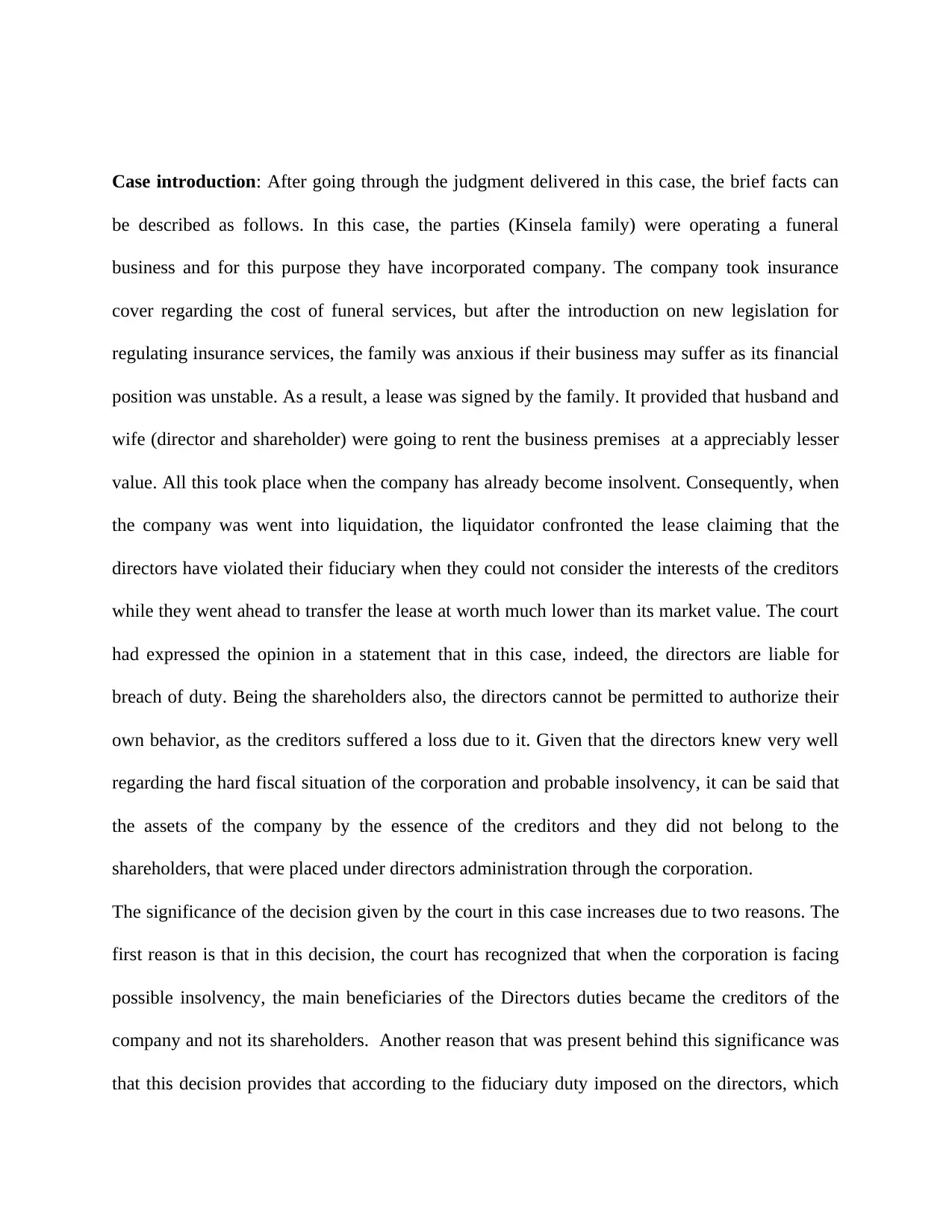
Case introduction: After going through the judgment delivered in this case, the brief facts can
be described as follows. In this case, the parties (Kinsela family) were operating a funeral
business and for this purpose they have incorporated company. The company took insurance
cover regarding the cost of funeral services, but after the introduction on new legislation for
regulating insurance services, the family was anxious if their business may suffer as its financial
position was unstable. As a result, a lease was signed by the family. It provided that husband and
wife (director and shareholder) were going to rent the business premises at a appreciably lesser
value. All this took place when the company has already become insolvent. Consequently, when
the company was went into liquidation, the liquidator confronted the lease claiming that the
directors have violated their fiduciary when they could not consider the interests of the creditors
while they went ahead to transfer the lease at worth much lower than its market value. The court
had expressed the opinion in a statement that in this case, indeed, the directors are liable for
breach of duty. Being the shareholders also, the directors cannot be permitted to authorize their
own behavior, as the creditors suffered a loss due to it. Given that the directors knew very well
regarding the hard fiscal situation of the corporation and probable insolvency, it can be said that
the assets of the company by the essence of the creditors and they did not belong to the
shareholders, that were placed under directors administration through the corporation.
The significance of the decision given by the court in this case increases due to two reasons. The
first reason is that in this decision, the court has recognized that when the corporation is facing
possible insolvency, the main beneficiaries of the Directors duties became the creditors of the
company and not its shareholders. Another reason that was present behind this significance was
that this decision provides that according to the fiduciary duty imposed on the directors, which
be described as follows. In this case, the parties (Kinsela family) were operating a funeral
business and for this purpose they have incorporated company. The company took insurance
cover regarding the cost of funeral services, but after the introduction on new legislation for
regulating insurance services, the family was anxious if their business may suffer as its financial
position was unstable. As a result, a lease was signed by the family. It provided that husband and
wife (director and shareholder) were going to rent the business premises at a appreciably lesser
value. All this took place when the company has already become insolvent. Consequently, when
the company was went into liquidation, the liquidator confronted the lease claiming that the
directors have violated their fiduciary when they could not consider the interests of the creditors
while they went ahead to transfer the lease at worth much lower than its market value. The court
had expressed the opinion in a statement that in this case, indeed, the directors are liable for
breach of duty. Being the shareholders also, the directors cannot be permitted to authorize their
own behavior, as the creditors suffered a loss due to it. Given that the directors knew very well
regarding the hard fiscal situation of the corporation and probable insolvency, it can be said that
the assets of the company by the essence of the creditors and they did not belong to the
shareholders, that were placed under directors administration through the corporation.
The significance of the decision given by the court in this case increases due to two reasons. The
first reason is that in this decision, the court has recognized that when the corporation is facing
possible insolvency, the main beneficiaries of the Directors duties became the creditors of the
company and not its shareholders. Another reason that was present behind this significance was
that this decision provides that according to the fiduciary duty imposed on the directors, which
Paraphrase This Document
Need a fresh take? Get an instant paraphrase of this document with our AI Paraphraser
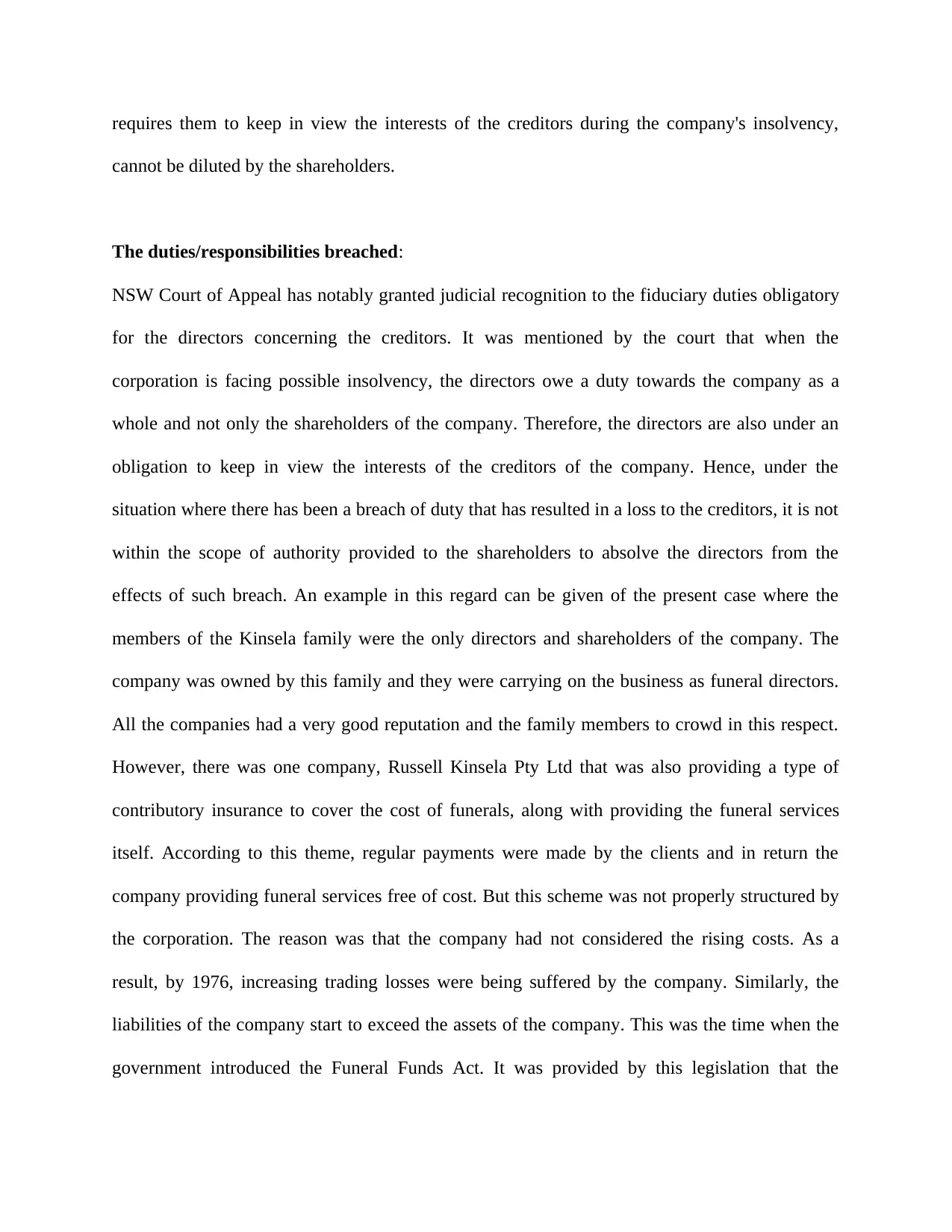
requires them to keep in view the interests of the creditors during the company's insolvency,
cannot be diluted by the shareholders.
The duties/responsibilities breached:
NSW Court of Appeal has notably granted judicial recognition to the fiduciary duties obligatory
for the directors concerning the creditors. It was mentioned by the court that when the
corporation is facing possible insolvency, the directors owe a duty towards the company as a
whole and not only the shareholders of the company. Therefore, the directors are also under an
obligation to keep in view the interests of the creditors of the company. Hence, under the
situation where there has been a breach of duty that has resulted in a loss to the creditors, it is not
within the scope of authority provided to the shareholders to absolve the directors from the
effects of such breach. An example in this regard can be given of the present case where the
members of the Kinsela family were the only directors and shareholders of the company. The
company was owned by this family and they were carrying on the business as funeral directors.
All the companies had a very good reputation and the family members to crowd in this respect.
However, there was one company, Russell Kinsela Pty Ltd that was also providing a type of
contributory insurance to cover the cost of funerals, along with providing the funeral services
itself. According to this theme, regular payments were made by the clients and in return the
company providing funeral services free of cost. But this scheme was not properly structured by
the corporation. The reason was that the company had not considered the rising costs. As a
result, by 1976, increasing trading losses were being suffered by the company. Similarly, the
liabilities of the company start to exceed the assets of the company. This was the time when the
government introduced the Funeral Funds Act. It was provided by this legislation that the
cannot be diluted by the shareholders.
The duties/responsibilities breached:
NSW Court of Appeal has notably granted judicial recognition to the fiduciary duties obligatory
for the directors concerning the creditors. It was mentioned by the court that when the
corporation is facing possible insolvency, the directors owe a duty towards the company as a
whole and not only the shareholders of the company. Therefore, the directors are also under an
obligation to keep in view the interests of the creditors of the company. Hence, under the
situation where there has been a breach of duty that has resulted in a loss to the creditors, it is not
within the scope of authority provided to the shareholders to absolve the directors from the
effects of such breach. An example in this regard can be given of the present case where the
members of the Kinsela family were the only directors and shareholders of the company. The
company was owned by this family and they were carrying on the business as funeral directors.
All the companies had a very good reputation and the family members to crowd in this respect.
However, there was one company, Russell Kinsela Pty Ltd that was also providing a type of
contributory insurance to cover the cost of funerals, along with providing the funeral services
itself. According to this theme, regular payments were made by the clients and in return the
company providing funeral services free of cost. But this scheme was not properly structured by
the corporation. The reason was that the company had not considered the rising costs. As a
result, by 1976, increasing trading losses were being suffered by the company. Similarly, the
liabilities of the company start to exceed the assets of the company. This was the time when the
government introduced the Funeral Funds Act. It was provided by this legislation that the
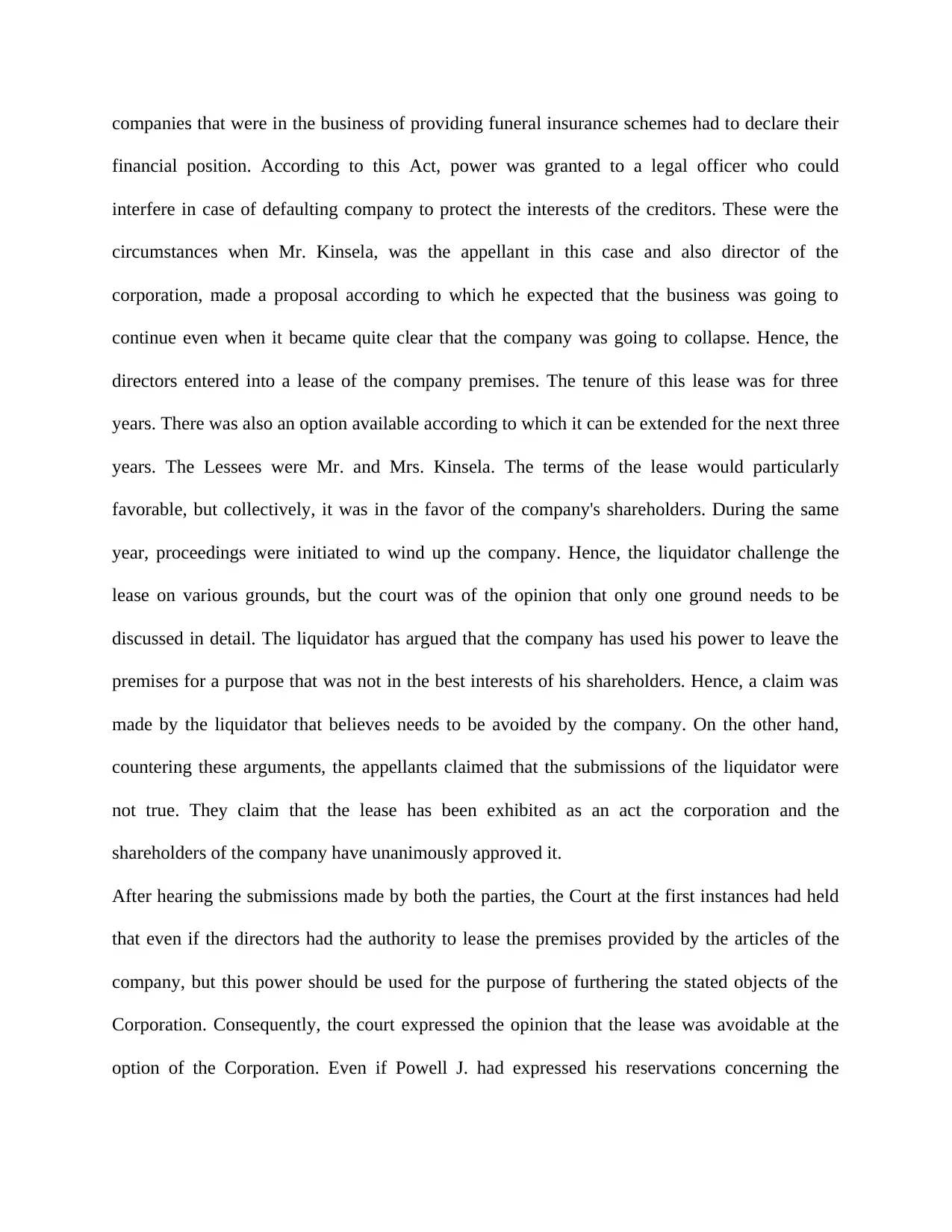
companies that were in the business of providing funeral insurance schemes had to declare their
financial position. According to this Act, power was granted to a legal officer who could
interfere in case of defaulting company to protect the interests of the creditors. These were the
circumstances when Mr. Kinsela, was the appellant in this case and also director of the
corporation, made a proposal according to which he expected that the business was going to
continue even when it became quite clear that the company was going to collapse. Hence, the
directors entered into a lease of the company premises. The tenure of this lease was for three
years. There was also an option available according to which it can be extended for the next three
years. The Lessees were Mr. and Mrs. Kinsela. The terms of the lease would particularly
favorable, but collectively, it was in the favor of the company's shareholders. During the same
year, proceedings were initiated to wind up the company. Hence, the liquidator challenge the
lease on various grounds, but the court was of the opinion that only one ground needs to be
discussed in detail. The liquidator has argued that the company has used his power to leave the
premises for a purpose that was not in the best interests of his shareholders. Hence, a claim was
made by the liquidator that believes needs to be avoided by the company. On the other hand,
countering these arguments, the appellants claimed that the submissions of the liquidator were
not true. They claim that the lease has been exhibited as an act the corporation and the
shareholders of the company have unanimously approved it.
After hearing the submissions made by both the parties, the Court at the first instances had held
that even if the directors had the authority to lease the premises provided by the articles of the
company, but this power should be used for the purpose of furthering the stated objects of the
Corporation. Consequently, the court expressed the opinion that the lease was avoidable at the
option of the Corporation. Even if Powell J. had expressed his reservations concerning the
financial position. According to this Act, power was granted to a legal officer who could
interfere in case of defaulting company to protect the interests of the creditors. These were the
circumstances when Mr. Kinsela, was the appellant in this case and also director of the
corporation, made a proposal according to which he expected that the business was going to
continue even when it became quite clear that the company was going to collapse. Hence, the
directors entered into a lease of the company premises. The tenure of this lease was for three
years. There was also an option available according to which it can be extended for the next three
years. The Lessees were Mr. and Mrs. Kinsela. The terms of the lease would particularly
favorable, but collectively, it was in the favor of the company's shareholders. During the same
year, proceedings were initiated to wind up the company. Hence, the liquidator challenge the
lease on various grounds, but the court was of the opinion that only one ground needs to be
discussed in detail. The liquidator has argued that the company has used his power to leave the
premises for a purpose that was not in the best interests of his shareholders. Hence, a claim was
made by the liquidator that believes needs to be avoided by the company. On the other hand,
countering these arguments, the appellants claimed that the submissions of the liquidator were
not true. They claim that the lease has been exhibited as an act the corporation and the
shareholders of the company have unanimously approved it.
After hearing the submissions made by both the parties, the Court at the first instances had held
that even if the directors had the authority to lease the premises provided by the articles of the
company, but this power should be used for the purpose of furthering the stated objects of the
Corporation. Consequently, the court expressed the opinion that the lease was avoidable at the
option of the Corporation. Even if Powell J. had expressed his reservations concerning the
⊘ This is a preview!⊘
Do you want full access?
Subscribe today to unlock all pages.

Trusted by 1+ million students worldwide
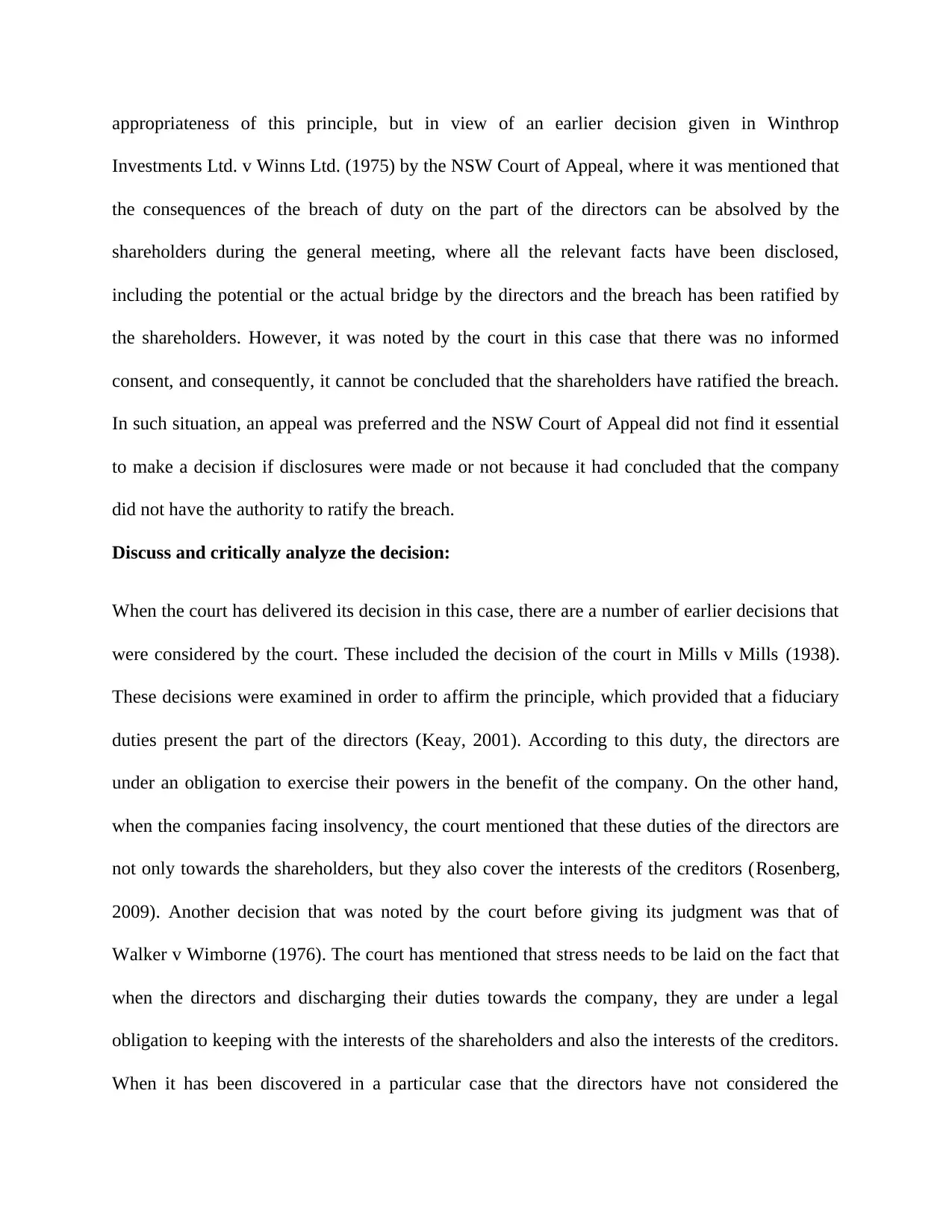
appropriateness of this principle, but in view of an earlier decision given in Winthrop
Investments Ltd. v Winns Ltd. (1975) by the NSW Court of Appeal, where it was mentioned that
the consequences of the breach of duty on the part of the directors can be absolved by the
shareholders during the general meeting, where all the relevant facts have been disclosed,
including the potential or the actual bridge by the directors and the breach has been ratified by
the shareholders. However, it was noted by the court in this case that there was no informed
consent, and consequently, it cannot be concluded that the shareholders have ratified the breach.
In such situation, an appeal was preferred and the NSW Court of Appeal did not find it essential
to make a decision if disclosures were made or not because it had concluded that the company
did not have the authority to ratify the breach.
Discuss and critically analyze the decision:
When the court has delivered its decision in this case, there are a number of earlier decisions that
were considered by the court. These included the decision of the court in Mills v Mills (1938).
These decisions were examined in order to affirm the principle, which provided that a fiduciary
duties present the part of the directors (Keay, 2001). According to this duty, the directors are
under an obligation to exercise their powers in the benefit of the company. On the other hand,
when the companies facing insolvency, the court mentioned that these duties of the directors are
not only towards the shareholders, but they also cover the interests of the creditors (Rosenberg,
2009). Another decision that was noted by the court before giving its judgment was that of
Walker v Wimborne (1976). The court has mentioned that stress needs to be laid on the fact that
when the directors and discharging their duties towards the company, they are under a legal
obligation to keeping with the interests of the shareholders and also the interests of the creditors.
When it has been discovered in a particular case that the directors have not considered the
Investments Ltd. v Winns Ltd. (1975) by the NSW Court of Appeal, where it was mentioned that
the consequences of the breach of duty on the part of the directors can be absolved by the
shareholders during the general meeting, where all the relevant facts have been disclosed,
including the potential or the actual bridge by the directors and the breach has been ratified by
the shareholders. However, it was noted by the court in this case that there was no informed
consent, and consequently, it cannot be concluded that the shareholders have ratified the breach.
In such situation, an appeal was preferred and the NSW Court of Appeal did not find it essential
to make a decision if disclosures were made or not because it had concluded that the company
did not have the authority to ratify the breach.
Discuss and critically analyze the decision:
When the court has delivered its decision in this case, there are a number of earlier decisions that
were considered by the court. These included the decision of the court in Mills v Mills (1938).
These decisions were examined in order to affirm the principle, which provided that a fiduciary
duties present the part of the directors (Keay, 2001). According to this duty, the directors are
under an obligation to exercise their powers in the benefit of the company. On the other hand,
when the companies facing insolvency, the court mentioned that these duties of the directors are
not only towards the shareholders, but they also cover the interests of the creditors (Rosenberg,
2009). Another decision that was noted by the court before giving its judgment was that of
Walker v Wimborne (1976). The court has mentioned that stress needs to be laid on the fact that
when the directors and discharging their duties towards the company, they are under a legal
obligation to keeping with the interests of the shareholders and also the interests of the creditors.
When it has been discovered in a particular case that the directors have not considered the
Paraphrase This Document
Need a fresh take? Get an instant paraphrase of this document with our AI Paraphraser
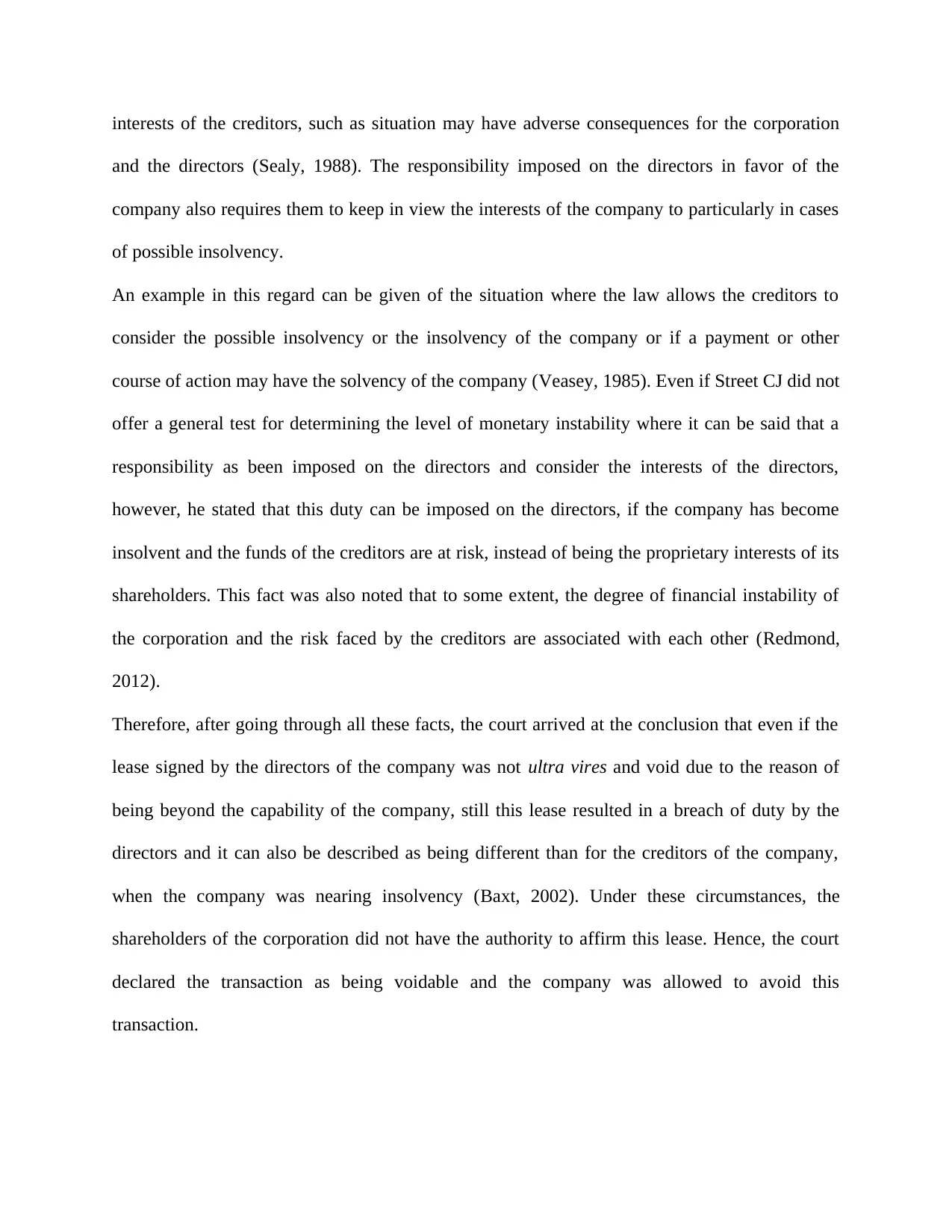
interests of the creditors, such as situation may have adverse consequences for the corporation
and the directors (Sealy, 1988). The responsibility imposed on the directors in favor of the
company also requires them to keep in view the interests of the company to particularly in cases
of possible insolvency.
An example in this regard can be given of the situation where the law allows the creditors to
consider the possible insolvency or the insolvency of the company or if a payment or other
course of action may have the solvency of the company (Veasey, 1985). Even if Street CJ did not
offer a general test for determining the level of monetary instability where it can be said that a
responsibility as been imposed on the directors and consider the interests of the directors,
however, he stated that this duty can be imposed on the directors, if the company has become
insolvent and the funds of the creditors are at risk, instead of being the proprietary interests of its
shareholders. This fact was also noted that to some extent, the degree of financial instability of
the corporation and the risk faced by the creditors are associated with each other (Redmond,
2012).
Therefore, after going through all these facts, the court arrived at the conclusion that even if the
lease signed by the directors of the company was not ultra vires and void due to the reason of
being beyond the capability of the company, still this lease resulted in a breach of duty by the
directors and it can also be described as being different than for the creditors of the company,
when the company was nearing insolvency (Baxt, 2002). Under these circumstances, the
shareholders of the corporation did not have the authority to affirm this lease. Hence, the court
declared the transaction as being voidable and the company was allowed to avoid this
transaction.
and the directors (Sealy, 1988). The responsibility imposed on the directors in favor of the
company also requires them to keep in view the interests of the company to particularly in cases
of possible insolvency.
An example in this regard can be given of the situation where the law allows the creditors to
consider the possible insolvency or the insolvency of the company or if a payment or other
course of action may have the solvency of the company (Veasey, 1985). Even if Street CJ did not
offer a general test for determining the level of monetary instability where it can be said that a
responsibility as been imposed on the directors and consider the interests of the directors,
however, he stated that this duty can be imposed on the directors, if the company has become
insolvent and the funds of the creditors are at risk, instead of being the proprietary interests of its
shareholders. This fact was also noted that to some extent, the degree of financial instability of
the corporation and the risk faced by the creditors are associated with each other (Redmond,
2012).
Therefore, after going through all these facts, the court arrived at the conclusion that even if the
lease signed by the directors of the company was not ultra vires and void due to the reason of
being beyond the capability of the company, still this lease resulted in a breach of duty by the
directors and it can also be described as being different than for the creditors of the company,
when the company was nearing insolvency (Baxt, 2002). Under these circumstances, the
shareholders of the corporation did not have the authority to affirm this lease. Hence, the court
declared the transaction as being voidable and the company was allowed to avoid this
transaction.
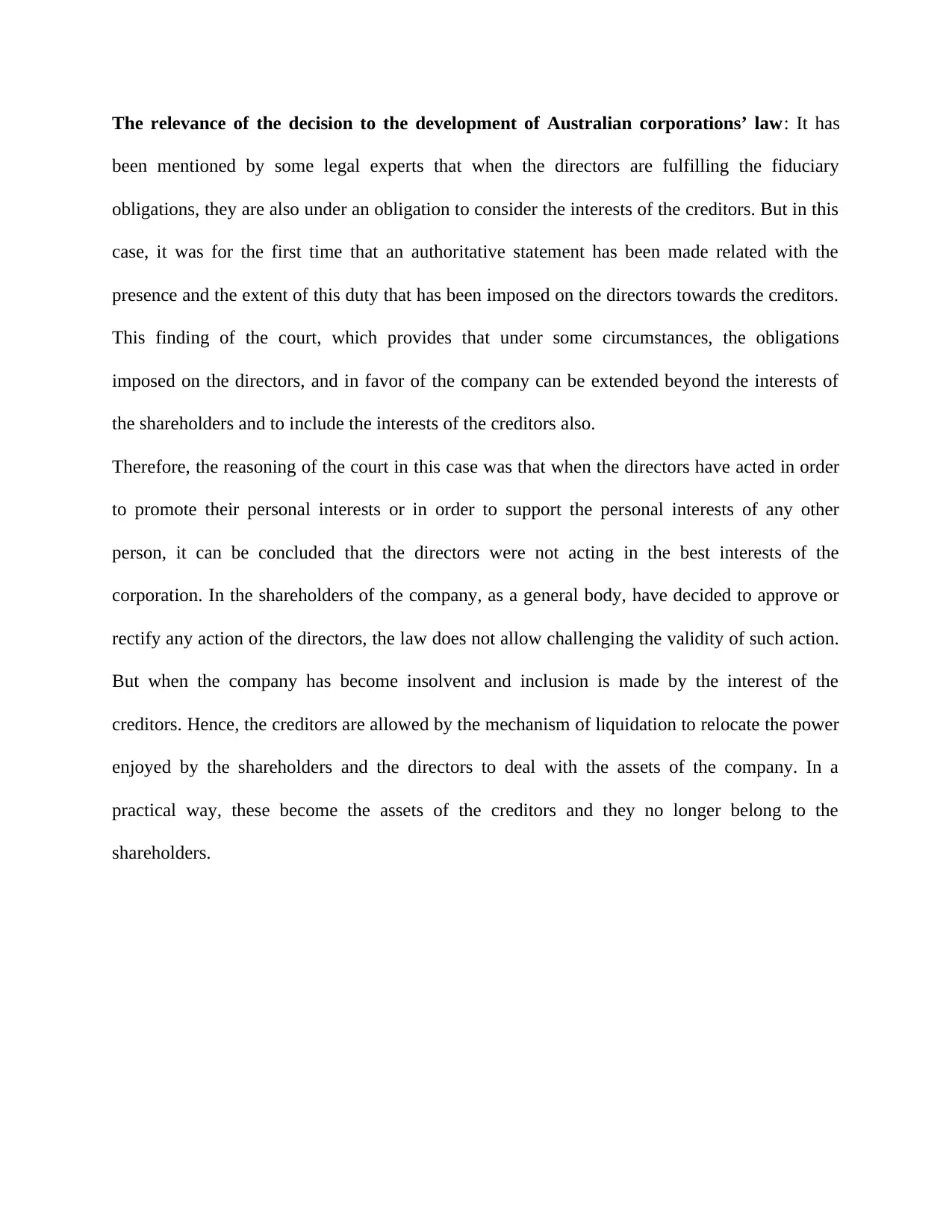
The relevance of the decision to the development of Australian corporations’ law: It has
been mentioned by some legal experts that when the directors are fulfilling the fiduciary
obligations, they are also under an obligation to consider the interests of the creditors. But in this
case, it was for the first time that an authoritative statement has been made related with the
presence and the extent of this duty that has been imposed on the directors towards the creditors.
This finding of the court, which provides that under some circumstances, the obligations
imposed on the directors, and in favor of the company can be extended beyond the interests of
the shareholders and to include the interests of the creditors also.
Therefore, the reasoning of the court in this case was that when the directors have acted in order
to promote their personal interests or in order to support the personal interests of any other
person, it can be concluded that the directors were not acting in the best interests of the
corporation. In the shareholders of the company, as a general body, have decided to approve or
rectify any action of the directors, the law does not allow challenging the validity of such action.
But when the company has become insolvent and inclusion is made by the interest of the
creditors. Hence, the creditors are allowed by the mechanism of liquidation to relocate the power
enjoyed by the shareholders and the directors to deal with the assets of the company. In a
practical way, these become the assets of the creditors and they no longer belong to the
shareholders.
been mentioned by some legal experts that when the directors are fulfilling the fiduciary
obligations, they are also under an obligation to consider the interests of the creditors. But in this
case, it was for the first time that an authoritative statement has been made related with the
presence and the extent of this duty that has been imposed on the directors towards the creditors.
This finding of the court, which provides that under some circumstances, the obligations
imposed on the directors, and in favor of the company can be extended beyond the interests of
the shareholders and to include the interests of the creditors also.
Therefore, the reasoning of the court in this case was that when the directors have acted in order
to promote their personal interests or in order to support the personal interests of any other
person, it can be concluded that the directors were not acting in the best interests of the
corporation. In the shareholders of the company, as a general body, have decided to approve or
rectify any action of the directors, the law does not allow challenging the validity of such action.
But when the company has become insolvent and inclusion is made by the interest of the
creditors. Hence, the creditors are allowed by the mechanism of liquidation to relocate the power
enjoyed by the shareholders and the directors to deal with the assets of the company. In a
practical way, these become the assets of the creditors and they no longer belong to the
shareholders.
⊘ This is a preview!⊘
Do you want full access?
Subscribe today to unlock all pages.

Trusted by 1+ million students worldwide
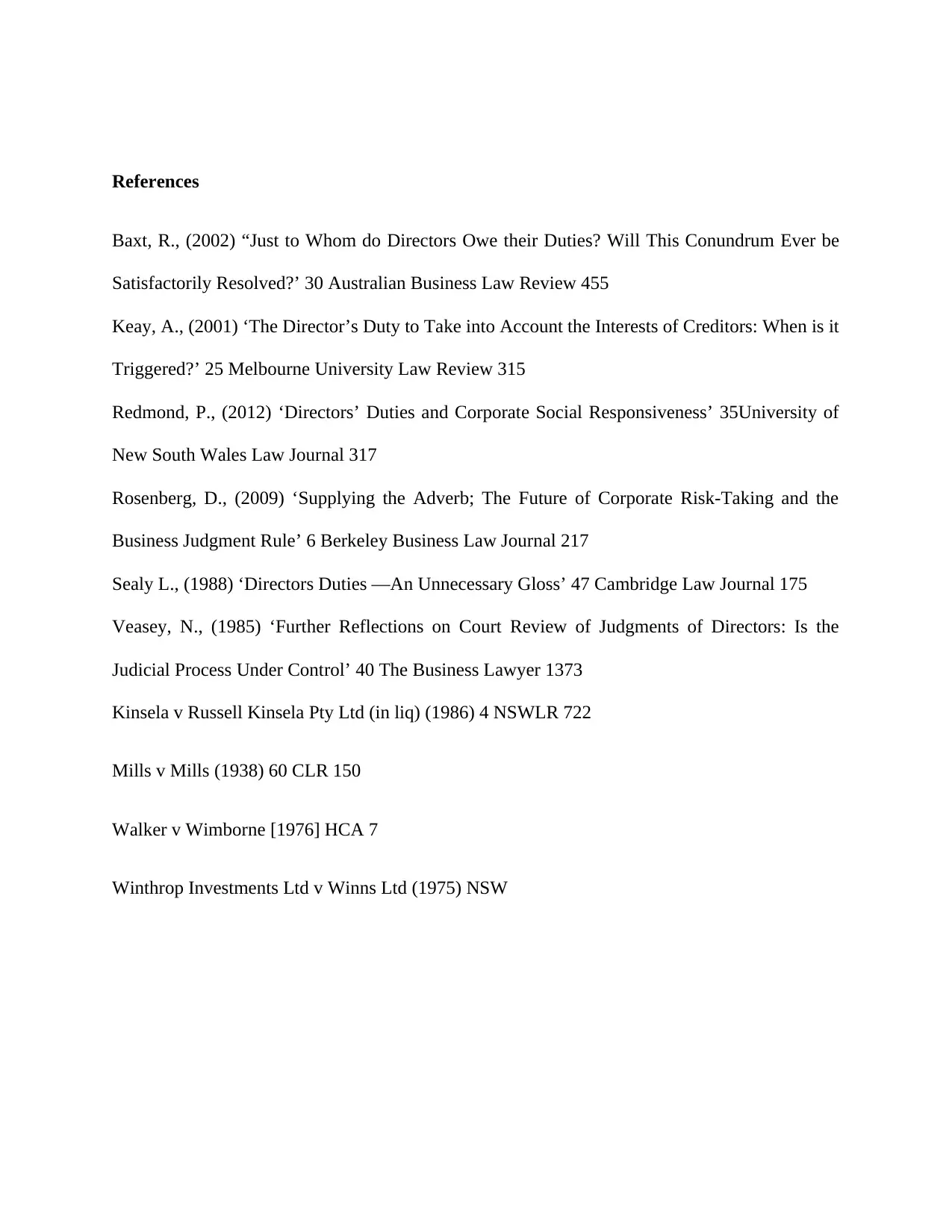
References
Baxt, R., (2002) “Just to Whom do Directors Owe their Duties? Will This Conundrum Ever be
Satisfactorily Resolved?’ 30 Australian Business Law Review 455
Keay, A., (2001) ‘The Director’s Duty to Take into Account the Interests of Creditors: When is it
Triggered?’ 25 Melbourne University Law Review 315
Redmond, P., (2012) ‘Directors’ Duties and Corporate Social Responsiveness’ 35University of
New South Wales Law Journal 317
Rosenberg, D., (2009) ‘Supplying the Adverb; The Future of Corporate Risk-Taking and the
Business Judgment Rule’ 6 Berkeley Business Law Journal 217
Sealy L., (1988) ‘Directors Duties —An Unnecessary Gloss’ 47 Cambridge Law Journal 175
Veasey, N., (1985) ‘Further Reflections on Court Review of Judgments of Directors: Is the
Judicial Process Under Control’ 40 The Business Lawyer 1373
Kinsela v Russell Kinsela Pty Ltd (in liq) (1986) 4 NSWLR 722
Mills v Mills (1938) 60 CLR 150
Walker v Wimborne [1976] HCA 7
Winthrop Investments Ltd v Winns Ltd (1975) NSW
Baxt, R., (2002) “Just to Whom do Directors Owe their Duties? Will This Conundrum Ever be
Satisfactorily Resolved?’ 30 Australian Business Law Review 455
Keay, A., (2001) ‘The Director’s Duty to Take into Account the Interests of Creditors: When is it
Triggered?’ 25 Melbourne University Law Review 315
Redmond, P., (2012) ‘Directors’ Duties and Corporate Social Responsiveness’ 35University of
New South Wales Law Journal 317
Rosenberg, D., (2009) ‘Supplying the Adverb; The Future of Corporate Risk-Taking and the
Business Judgment Rule’ 6 Berkeley Business Law Journal 217
Sealy L., (1988) ‘Directors Duties —An Unnecessary Gloss’ 47 Cambridge Law Journal 175
Veasey, N., (1985) ‘Further Reflections on Court Review of Judgments of Directors: Is the
Judicial Process Under Control’ 40 The Business Lawyer 1373
Kinsela v Russell Kinsela Pty Ltd (in liq) (1986) 4 NSWLR 722
Mills v Mills (1938) 60 CLR 150
Walker v Wimborne [1976] HCA 7
Winthrop Investments Ltd v Winns Ltd (1975) NSW
1 out of 7
Related Documents
Your All-in-One AI-Powered Toolkit for Academic Success.
+13062052269
info@desklib.com
Available 24*7 on WhatsApp / Email
![[object Object]](/_next/static/media/star-bottom.7253800d.svg)
Unlock your academic potential
Copyright © 2020–2025 A2Z Services. All Rights Reserved. Developed and managed by ZUCOL.





